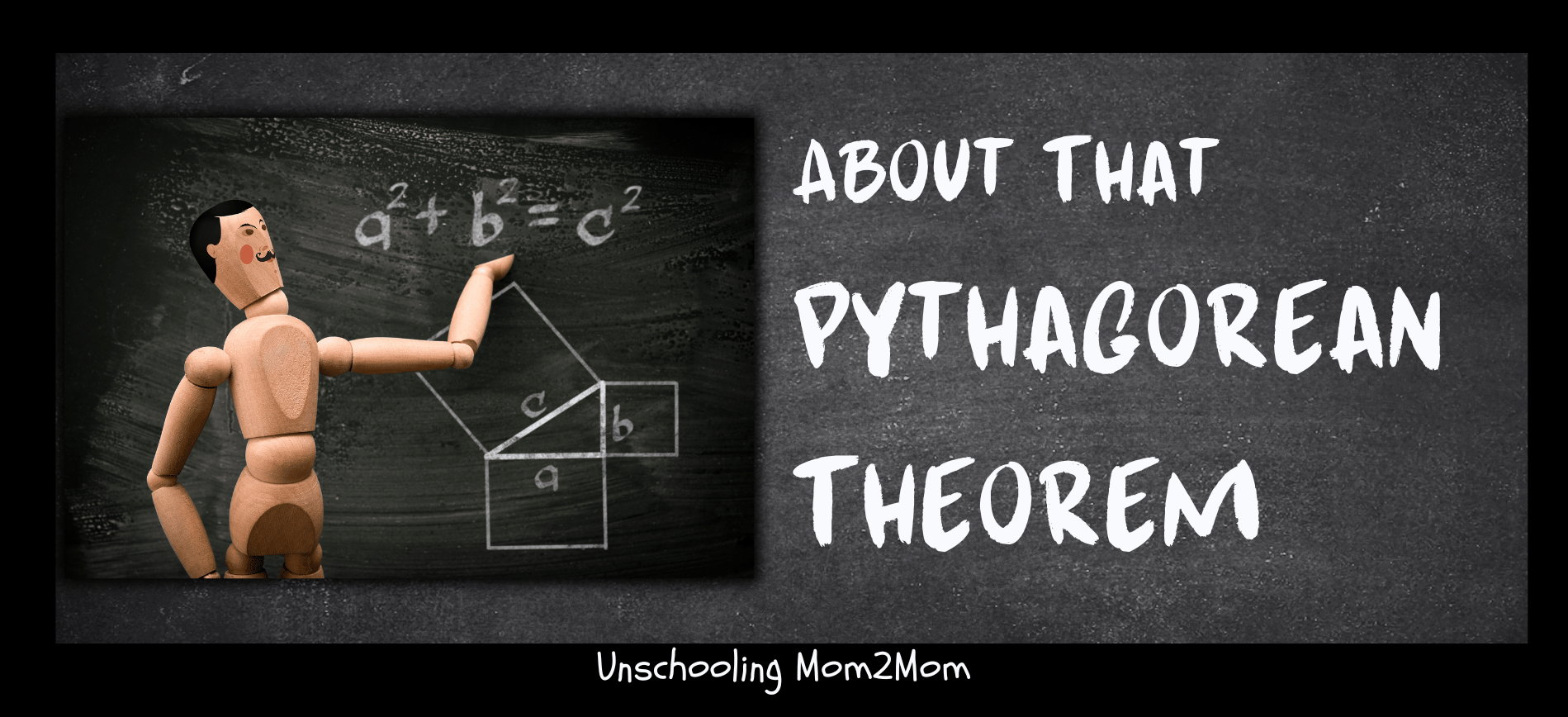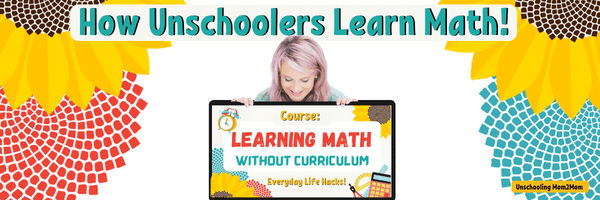What about the Pythagorean Theorem?
"I Never Once Have Needed to Know the Pythagorean Theorem"
Perhaps not. That's certainly what I used to say all the time: All that unnecessary memorization in school didn't help me in REAL Life. But there's a difference between memorizing the theorem for a test, and actually USING the concept in everyday activities.
I was being interviewed on a podcast and my husband overheard me saying,
"I don't use the Pythagorean Theorem as a fully functioning adult. Yet so much time in school focused on those kinds of things."
He said to me later,
"I use the Pythagorean theorem all the time."
"WHAT??? HOW? WHY?"
He is an amateur photographer and spent a lot of time photographing the stars and planets. He told me he had to use the theorem to calculate distances between these celestial objects, analyzing the angles, making observations. All of that was necessary to find what he wanted to photograph.
Well. Who knew?

Social Media Buzzing
Lately on Social media, a lot of discussion circled around some posts saying they don't use the Pythagorean Theorem. I immediately thought of what my husband had said, and started pondering more. Reading the comments in some of those posts really helped me solidify some things.
It's not that we don't USE the Pythagorean Theorem. We do. All the time. Chat GPT showed me over 75 actual uses in daily life where we ARE using the Pythagorean theorem - we're just not calling it that. Or writing it out formulaically. (I had to look that up to see if it's a real work - and it is!)
I'll show you what I discovered for all this real life application below.
If only we we had the opportunity to play with math problems like building and measuring - instead of solving problems on a sheet of paper. If we had had someone talk to us about it more when we were in school, instead of memorizing a ton of random formulas for a test, we might all have less math anxiety and be much more aware of how math-y we really are!
We certainly wouldn't wander around saying
"I never use the Pythagorean Theorem!"
Because nothing could be farther from the truth!
People are beginning to see that Real Life DOES offer opportunities to learn and practice all sorts of skills and concepts.
AND, I think the curtain is being pulled back and everyone is also seeing that the school approach to learning - memorizing random factoids without any practical application - is wasting people's time. With no body of knowledge or experience to "hook" the abstract information onto, it's forgotten.
The
"Some Day You'll Need This," response has grown tedious. Especially when we, as adults, unaware of the practical application of said skills, don't see that we're using it at all. It's not uncommon to hear parents growing a little resentful of all those years being told "trust us, some day..." and when we asked for examples, none were provided. Probably because our teachers had only memorized the answers too. A rare few actually saw how these concepts weave through life and then shared that with us. Or maybe they were so distracted that the standardized test score was imminent, the memorization became the priority. No time for messing with quilt patterns or building stairs.
So this is my little Public Service Announcement so you can know better/do better.
We learn math to solve problems. Real problems. Not because we're trying to grow our neural connections, as some are saying on Instagram. Neural connections grow when we are engaged in activities that challenge us. And we stick with challenging activities when we're trying to solve something we're curious about or are trying to DO something we couldn't before.
We don't learn for the sake of learning, we learn because we're curious. Parents who push learning for it's own sake, are really pushing their child to STOP being curious, and learn what the parent wants them to know. And then they wonder what happened to their child's inner motivation. They had a hand in squashing that. Healthy human brains don't typically enjoy following someone else's directions all the time. So these ideas that are being poured onto the child don't usually stick with them. No wonder parents who homeschool in a more traditional way are so burnt out. They're using a playbook that doesn't really fit their learner. I get it, deviating from the traditional approach can be scary. And we all have plenty of people in our lives who want to remind us to get back in line. But we know our kids deserve more. They deserve better. You may not know what that is, but you're pretty clear what it ISN'T.
I know.
Unschooling can be an unpopular opinion. But I invite you to simply broaden the way you approach learning.
Walk away from random memorization and regurgitating facts. Give creativity and curiosity a little room to grow.
Engage in life WITH your kids! Connecting more with them will help you see what your next steps should be. You don't need a curriculum company to tell you.
Look at these Videos
Looking at "kid" videos will give you a quick brush-up on what the Pythagorean Theorem means. And then hop below to see Real Life examples of using it.
The Pythagorean theorem, which states that in a right-angled triangle, the square of the length of the hypotenuse (the side opposite the right angle) is equal to the sum of the squares of the lengths of the other two sides, and it has numerous applications in real life.
Don't take this as me telling you to make the kids memorize the Pythagorean Theorem
I really DON'T want you to now go back to the kids and say,
"You need to memorize the Pythagorean Theorem because its a really important piece of information."
Because, THAT would be like school. Randomly plucking something from the air and forcing kids to memorize without any practical life connection. And that's not a good plan at all. Schools typically don't introduce things like the Pythagorean Theorem until kids are around 13 or 14.
But kids who enjoy mathy puzzles or are wondering,
"Do we ever do any Algebra?"... show them these three videos!
Let them know that sometimes, when we have to solve problems that are missing components - or we don't know all the pieces we need to know - things like this are useful. We can figure out the measurement we're looking for!
And, if you’re not an unschooler and you are teaching these random things, now at least you’ll have a better answer for,
“Why do we have to learn these things?”
You can tell them that using the theorem will help you in building, getting the stairs built correctly or the roofline, tiling floors or painting geometric patterns.
Here, I'll show you what our little Robot Friend at ChatGPT showed me:
75 Ways We Use the Pythagorean Theorem
Architecture:
Architects use the theorem to ensure stability and balance in structures, especially when designing roofs and supporting beams.
- Roof Design: Architects use the Pythagorean theorem to calculate the diagonal distance and angles of pitched roofs, ensuring stability and proper support.
- Structural Stability: When designing buildings, architects apply the theorem to analyze and ensure the stability of load-bearing walls and supporting columns.
- Floor Layout: The theorem is used to measure and mark right angles in the layout of floors and rooms, ensuring accurate placement of walls and corners.
Sports:
Calculating distances and angles for better accuracy.
- Basketball Shot Angles: Basketball players use the theorem to calculate optimal shooting angles for better accuracy.
- Soccer Goalkeeper Positioning: Goalkeepers apply the theorem to calculate distances and angles when positioning themselves to defend the goal.
- Baseball Field Dimensions: Groundskeepers and players use the theorem to calculate dimensions and distances on baseball fields for accurate gameplay.
Fitness:
- Yoga Mat Placement: Practitioners use the theorem to align yoga mats at right angles, ensuring a proper and comfortable practice space.
- Golf Shot Planning: Golfers apply the theorem to calculate distances and angles when planning shots on the course.
- Exercise Equipment Setup: Individuals setting up home gyms use the theorem to position equipment at optimal angles for effective workouts.
Photography:
Photographers use the theorem to calculate distances and angles for framing shots.
- Framing Shots: Photographers use the theorem to calculate distances and angles when framing shots for composition.
- Tripod Placement: When using tripods, photographers apply the theorem to ensure stable placement and proper angles for capturing images.
- Rule of Thirds: The rule of thirds in photography involves applying the theorem to divide the frame into visually appealing sections.
Game Development:
Game developers use the theorem for collision detection and pathfinding algorithms in virtual environments.
- Collision Detection: Game developers use the theorem for collision detection algorithms to determine when game objects intersect.
- Pathfinding Algorithms: The theorem is applied in pathfinding algorithms to calculate distances and angles for optimal movement of characters in games.
- Virtual Environment Design: Designers use the theorem to create realistic virtual environments by calculating distances and angles in 3D space.
- Computer graphics: the theorem is used to calculate distances and angles, enabling the creation of realistic images.
Robotics & Electronics:
Engineers use the theorem for design robot movements and ensuring precise positioning, calculating circuit parameters and signal processing.
- Path Planning: Engineers in robotics use the Pythagorean theorem for path planning algorithms, calculating distances and angles for efficient and obstacle-free movement.
- Arm Movements: In robot arms and manipulators, the theorem is applied to calculate the length and angles of each segment, ensuring precise and coordinated movements.
- Localization Systems: The theorem is used in robotics for localization systems, calculating distances between known reference points to determine the robot's position accurately.
- Signal Propagation: In electronics, especially in the design of communication systems, the theorem is used to calculate signal propagation distances and angles for optimal transmission.
- Circuit Board Layout: Engineers apply the theorem in designing circuit boards, ensuring that components are placed at optimal distances and angles for efficient signal processing.
- Antenna Placement: When designing antennas for communication devices, the theorem helps calculate the distance & angle between antennas for optimal signal reception.
Mechanical Design:
Mechanical designers use the theorem to ensure proper alignment and fit in mechanical components.
- Machine Assembly: Mechanical designers use the Pythagorean theorem to ensure proper alignment and fit in the assembly of mechanical components.
- Gear Ratios: Engineers apply the theorem to calculate distances and angles in gear systems, ensuring proper functioning.
- Product Design:
Designers use the theorem in mechanical product design to ensure symmetry and balance in the layout.
Car Design:
Engineers in automotive design use the theorem to ensure proper alignment and stability in vehicle structures.
These examples highlight the versatility and wide-ranging applications of the Pythagorean theorem in various fields.
- Wheel Alignment: Automotive engineers use the theorem to calculate distances and angles for proper wheel alignment.
- Vehicle Stability Analysis: Engineers apply the theorem in analyzing the stability of vehicle structures and components.
- Crash Test Simulation: In safety testing, the theorem is used to simulate and analyze the effects of collisions on vehicle structures.
Meteorology:
Weather predictions come from using the theorem to calculate distances and analyzing wind patterns.
- Wind Pattern Analysis: Meteorologists use the theorem to analyze wind patterns by calculating distances and angles between weather stations.
- Weather Balloon Trajectory: The theorem helps calculate the trajectory of weather balloons based on recorded data.
- Distance Between Weather Systems: Calculations are made using the theorem.
Home DIY and Carpentry:
Builders use the theorem to measure and mark right angles during construction, ensuring accuracy in the placement of walls and corners.
- Furniture Placement: Homeowners use the theorem to measure and ensure the right angles for placing furniture in rooms.
- Wall Painting: When painting walls with geometric patterns, individuals apply the Pythagorean theorem to create accurate angles and distances.
- Tiling Floors: DIY enthusiasts use the theorem to ensure precise placement of tiles on floors and walls, maintaining symmetry.During tile installation, renovators use the theorem to calculate the diagonal distance between corners and ensure tiles are laid evenly.
- Room Expansion: Homeowners applying room extensions or renovations use the theorem to measure and maintain proper angles for new walls and structures.
- Staircase Construction: When building or renovating staircases, the Pythagorean theorem is used to calculate the length of the railing or the diagonal distance of steps.
- Christmas Lights: Calculating how many strands you'll need
Gardening:
Gardeners use the theorem to plan and layout their garden aesthetics and functionality.
- Plot Layout: Gardeners use the theorem to measure and arrange garden plots in a way that maximizes space and sunlight exposure.
- Path Design: Creating diagonal paths in a garden involves applying the Pythagorean theorem to ensure accurate angles and distances.
- Fencing Placement: When installing fences, gardeners use the theorem to calculate the correct angles for corners and ensure a proper fit.
Cooking:
- Measuring Ingredients: When following recipes, cooks may use the theorem to calculate diagonal distances on cutting boards or countertops for accurate ingredient measurements.
- Kitchen Design: In kitchen layout and design, homeowners use the Pythagorean theorem to ensure that cabinets and appliances are arranged at right angles.
- Plating Presentation: Chefs apply the theorem for precise plating arrangements, creating visually appealing and balanced presentations.
Sewing
Seamstresses use the theorem for accurate measurements and precision
- Seamstresses Lining up angles or when following patterns
- Fashion Designers use the theorem for fabric draping, creating patterns, garment construction, fit/proportion
- Quilters use for checking squareness in quilting
Sound Engineering:
Sound engineers use the theorem to calculate distances and angles in the placement of speakers for optimal sound distribution.
- Speaker Placement: Sound engineers use the theorem to calculate distances and angles for optimal placement of speakers in venues.
- Acoustic Analysis: The Pythagorean theorem is employed in acoustic analysis to determine the optimal positioning of sound-absorbing materials.
- Stage Design: In live performances, sound engineers use the theorem to design stages and speaker arrangements for optimal sound distribution.
Art and Design:
Artists and designers use the theorem for creating visually appealing compositions and perspectives.
- Perspective Drawing: Artists use the Pythagorean theorem in perspective drawing to create accurate representations of three-dimensional space.
- Visual Composition: Designers apply the theorem in visual composition to arrange elements with balanced proportions and angles.
- Creating Symmetrical Artwork: Artists use the theorem to ensure symmetry in the creation of artwork, maintaining aesthetic appeal.
GPS Navigation:
GPS systems use the theorem to calculate distances between points on a map, helping with navigation.
- Route Planning: GPS systems use the Pythagorean theorem to calculate the direct distance between two points, aiding in optimal route planning for navigation.
- Location Accuracy: The theorem is applied to estimate the accuracy of a GPS location by comparing the calculated distance with the received signals from multiple satellites.
- Geofencing: GPS-based applications use the theorem to create geofences by determining whether a user's location is within a specified boundary.
- Air Travel: Pilots and navigators use the theorem in aviation to calculate distances and angles for flight paths.
Mapmaking, Geography, & Cartography:
Mapmakers use the theorem to ensure accuracy in mapping and representing distances on maps.
- Map Scale Calculations: Cartographers use the Pythagorean theorem to calculate distances on maps based on the scale.
- Map Accuracy Assessment: GIS professionals apply the theorem to assess the accuracy of maps by comparing calculated distances with actual measurements.
- Creating Thematic Maps: When creating thematic maps, cartographers use the theorem to measure and represent distances accurately.
- Surveyors calculate distances and angles when mapping out land or designing landscapes.
Medical Imaging:
In medical imaging, such as X-rays and CT scans, the theorem is used to calculate distances and angles for accurate imaging.
- CT Scan Reconstruction: In computed tomography (CT) scans, the theorem is used to calculate the three-dimensional position of each pixel during image reconstruction.
- X-ray Distance Calculation: Radiologists apply the theorem to calculate distances within the body, aiding in accurate diagnosis and treatment planning.
- MRI Imaging Angles: The Pythagorean theorem is used to calculate angles and distances in magnetic resonance imaging (MRI), contributing to precise imaging.
Larger Subject/Topics that use Pythagorean Theorem
Engineering:
Engineers use the theorem to design and analyze structures, circuits, and mechanical systems.
- Circuit Design: Electrical engineers use the Pythagorean theorem to calculate distances and angles in circuit design for electronic components.
- Mechanical System Analysis: Engineers apply the theorem to analyze mechanical systems and ensure proper alignment and balance.
- Structural Integrity Checks: Structural engineers use the theorem to check the integrity of structures by calculating distances and angles in support systems.
Economics:
Economists may use the theorem in statistical analysis and modeling.
- Statistical Analysis: Economists may use the Pythagorean theorem in statistical analysis to calculate distances and relationships between economic variables.
- Market Research: Calculating distances between data points in market research using the theorem for accurate analysis.
- Modeling Economic Trends: Economic modelers may apply the theorem to model trends and relationships between economic factors.
Trigonometry:
The Pythagorean theorem is a fundamental concept in trigonometry, which is used in various fields such as physics, engineering, and computer science.
- Navigation Apps: Users apply trigonometry, including the Pythagorean theorem, when using navigation apps to calculate distances and angles for accurate directions.
- Robotics Movements: Individuals programming robots use trigonometry to calculate angles and distances for precise movements.
- Surveying Land: Surveyors employ trigonometry, including the Pythagorean theorem, to measure distances and angles when mapping out land.
Physics:
Physicists apply the theorem to analyze and solve problems related to distances, velocities, and forces.
- Projectile Motion: Students and professionals use the Pythagorean theorem to analyze the horizontal and vertical components of projectile motion.
- Force Vector Analysis: Physicists apply the theorem in vector analysis to calculate the magnitude of forces acting in different directions.
- Distance and Displacement Calculations: Everyday physics problems involve using the theorem to calculate distances and displacements in various scenarios.
I want to show you how to find the math everywhere in your life.
You'll never need to purchase another curriculum again AND
- better than that -
you will no longer stress about whether you're providing what you need for your child to learn about math!
I have it all for you in this course!
Listen to the Podcast:












